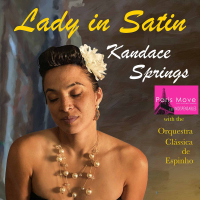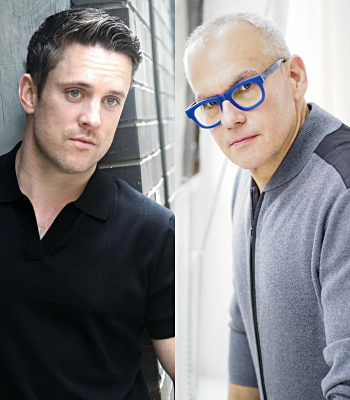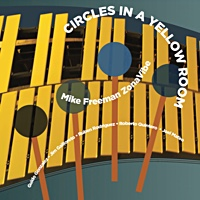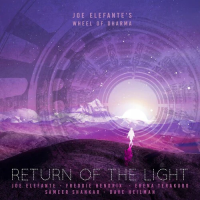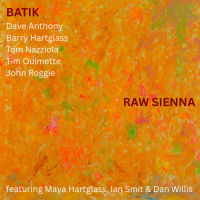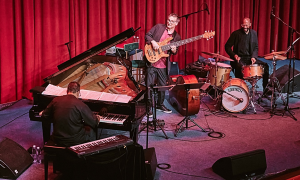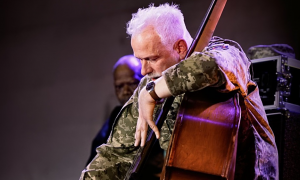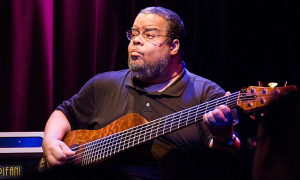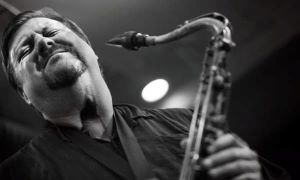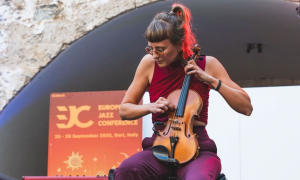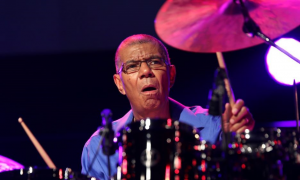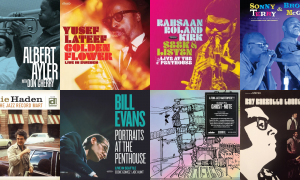Home » Jazz Articles » Profile » Jeremy Steig
Jeremy Steig
They play jazz in the elevator in Japan. You hear Thelonious Monk as you're going down.
 Artist/flutist Jeremy Steig colored some drawings in a cozy corner of his apartment one night last month, when he spilled a jar of ink. Not a pleasant mess, especially with Frac, Steig's gigantic cat pawing around. So the artist "banished" himself back to his drawing table covered with bamboo pens and Steig Ink (Uncle Arthur invented it).
Artist/flutist Jeremy Steig colored some drawings in a cozy corner of his apartment one night last month, when he spilled a jar of ink. Not a pleasant mess, especially with Frac, Steig's gigantic cat pawing around. So the artist "banished" himself back to his drawing table covered with bamboo pens and Steig Ink (Uncle Arthur invented it). This past February, an armful of Steig's profusely colorful illustrations livened up the Cornelia Street Café's stark white walls. One seemed to hum with the vibrant frenzy of a bustling jazz club right after the end of a set. Another relayed a peaceful moment between a bulbous woman and a strangely proportioned man. Back at his apartment Steig points to some drawings on the wall. "That's the stuff I couldn't have at Cornelia Street," he says. "I like to do nudes." He sifts through a manila folder bursting with works in progress, and loosely throws out titles, "The King Has No Clothes", "A Lap Dance", "The Flute Genie". Some might give the artist himself this label. Winding the frisky, wispy whirls and swirls of his flute around the beat of the rhythm section, he seems like a supernatural spirit. Your wish is his command.
Hugely influential in bringing flute to the jazz stage, Steig began on recorder at age 6 before starting flute studies with Paige Brook at age 11. In the '60s between sessions with Bill Evans, he played at a club on Bleeker Street with Paul Bley and Gary Peacock. "When Gary couldn't make it, Steve Swallow played bass, and when Paul couldn't, Carla Bley played."
At age 19 Steig suffered a motorbike accident in Bermuda that left half his face paralyzed. Six months later after undergoing microscopic surgery, he miraculously began playing again. "I didn't have the muscles in the left side of my mouth to hold the air in so if I blew, my lips would just open up. I figured that if I put something under my lips it would divert the air through the middle." So he created a mouthpiece out of cardboard and tape. He recorded his first two albums Flute Fever (Columbia, 1963) and Jeremy & The Satyrs (Reprise, 1968) with the mouthpiece, before building up enough muscle to play without it.
A pioneer in jazz rock, Steig played with Tommy Bolin, and Tim Hardin in the late '60s before forming his own group, Jeremy & The Satyrs. They landed a two and a half month residency at the Dom on St. Mark's Place playing six nights a week. Soon they headed west where they played opposite Cream at the Fillmore and Winterland. "[Cream was] recording Wheels Of Fire," he recalled. "Fillmore sat 3,000 and Winterland 5,000. It was just an amazing experience."
 A changing economy forced the Satyrs to break up, and Jeremy headed to Germany where he played with free jazz groups and had a reputation for being an honest musician. But in 1977 he recorded Firefly for CTI. "That's the kind of record where you do what they tell you to do," he said. "The Europeans got angry at me for doing that sort of record. They thought I had sold out. I think that was the start of the gigs not happening so much anymore."
A changing economy forced the Satyrs to break up, and Jeremy headed to Germany where he played with free jazz groups and had a reputation for being an honest musician. But in 1977 he recorded Firefly for CTI. "That's the kind of record where you do what they tell you to do," he said. "The Europeans got angry at me for doing that sort of record. They thought I had sold out. I think that was the start of the gigs not happening so much anymore." Back in New York Steig bought a four-track and started recording "flute bands" at home. He played all the parts - bass flute for bass, bottles for drums, and several flutes soloing over each other. After an equipment upgrade, he started inviting people over. Last year he recorded Jam with bassist Eddie Gomez, who he's played with off and on for the past 43 years, "We just played free," he explained. "We didn't decide on any keys, or say 'let's play blues.' We'd just start playing and finish when we felt like finishing."
A similar album with guitarist Vic Juris is in the works. "We think about music the same way," he said. "We like to play free, and we both like blues." Steig plans to have the record ready for their October trip to Japan. "They play jazz in the elevator in Japan. You hear Thelonious Monk as you're going down."
In the late '80s Steig got star billing in the rap world. The Beastie Boys used a sample from "Howlin' For Judy", in their hit track "Sure Shot". He got a kick out of seeing them perform it on Saturday Night Live. "I made more money from that sample than from any of my records. It saved my life at the time," he said.
Bobby Jaspar, Roland Kirk, James Moody, and Yusef Lateef who inspired him to start singing into the flute, are in Steig's opinion, some of the major contributors to the instrument. He remembers how he could never get a gig in the high school dance bands because they only wanted saxophone players who doubled on flute. "Back then flute wasn't getting it's due. But since then it's been in small groups, and in a small group, flute has just as much say."
Visit Jeremy Steig on the web.
Photo Credit
Rozanne Levine
Tags
PREVIOUS / NEXT
Support All About Jazz
 All About Jazz has been a pillar of jazz since 1995, championing it as an art form and, more importantly, supporting the musicians who make it. Our enduring commitment has made "AAJ" one of the most culturally important websites of its kind, read by hundreds of thousands of fans, musicians and industry figures every month.
All About Jazz has been a pillar of jazz since 1995, championing it as an art form and, more importantly, supporting the musicians who make it. Our enduring commitment has made "AAJ" one of the most culturally important websites of its kind, read by hundreds of thousands of fans, musicians and industry figures every month.









